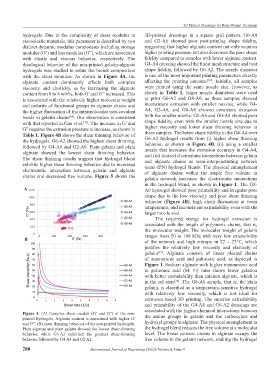Page 288 - IJB-8-4
P. 288
3D Printed Dressings for Burn Wound Treatment
hydrogels. Due to the complexity of shear modulus in 3D-printed dressings in a square grid pattern. G0-A8
viscoelastic materials, this parameter is described by two and G2-A6 showed poor post-printing shape fidelity,
distinct dynamic modulus components including storage suggesting that higher alginate content not only requires
modulus (G’) and loss modulus (G”), which are associated higher printing pressure but also decreases the pore shape
with elastic and viscous behavior, respectively. The fidelity compared to samples with lower alginate content.
rheological behavior of the non-printed gelatin-alginate G4-A4 dressing showed the finest mesh structure and best
hydrogels was studied to relate the bioink composition shape fidelity, followed by G6-A2. The nozzle diameter
with the shear modulus. As shown in Figure 4A, the is one of the most important printing parameters directly
[36]
alginate content dominantly affects both complex affecting the printing outcome . Initially, all samples
viscosity and elasticity, as by increasing the alginate were printed using the same nozzle size. However, as
content from 0 to 8 w/v%, both G’ and G” increased. This shown in Table 1, larger nozzle diameters were used
is associated with the relatively higher molecular weight to print G6-A2 and G8-A0, as these samples showed
and polarity of functional groups in alginate chains and inconsistent extrusion with smaller nozzles, while G4-
the higher fluctuation of the intramolecular non-covalent A4, G2-A6, and G0-A8 showed consistent extrusion
bonds in gelatin chains . Our observation is consistent with the smaller nozzle. G2-A6 and G0-A8 showed poor
[34]
with that reported in Gao et al. . The increase in G’ and shape fidelity, even with the smaller nozzle size due to
[35]
G” requires the extrusion pressure to increase, as shown in higher viscosity and lower shear thinning behavior in
Table 1. Figure 4B shows the shear thinning behavior of these samples. The better shape fidelity in the G4-A4 over
the hydrogels. G6-A2 showed the highest shear thinning, G6-A2 hydrogel results from (i) higher shear thinning
followed by G4-A4 and G2-A6. Plain gelatin and plain behavior, as shown in Figure 4B, (ii) using a smaller
nozzle that increases the extrusion accuracy in G4-A4,
alginate showed the lowest shear thinning behavior. and (iii) desired electrostatic interactions between gelatin
The shear thinning results suggest that hydrogel blend and alginate chains as semi-interpenetrating network
exhibits higher shear thinning behavior due to increased (semi-IPN) hydrogel blends. The physical entanglement
electrostatic interaction between gelatin and alginate of alginate chains within the ample free volume in
chains and decreased free volume. Figure 5 shows the gelatin network increases the electrostatic interactions
in the hydrogel blend, as shown in Figure 1. The G8-
A A0 hydrogel showed poor printability and irregular pore
shape due to the low viscosity and poor shear thinning
behavior (Figure 4B), high chain fluctuation at room
temperature, and inconsistent extrudability even with the
larger nozzle size.
The required energy for hydrogel extrusion is
associated with the length of polymeric chains, that is,
the molecular weight. The molecular weight of gelatin
ranges from 50 to 100 kDa with very low extensibility
B of the network and high entropy in 22 – 23°C, which
justifies the relatively low viscosity and elasticity of
gelatin . Alginate consists of linear pleated chains
[37]
of mannuronic acid and guluronic acid, as depicted in
Figure 1. Sodium alginate with higher mannuronic acid
to guluronic acid (M: G) ratio shows lower gelation
with better extrudability than calcium alginate, which is
in the sol state . The G8-A0 sample, that is, the plain
[38]
gelatin, is classified as a temperature-sensitive hydrogel
with relatively low viscosity, which is not ideal for
extrusion-based 3D printing. The superior extrudability
and printability of the G4-A4 and G6-A2 dressings are
associated with the higher chemical interactions between
Figure 4. (A) Complex shear moduli (G’ and G”) of the non-
printed hydrogels. Alginate content is associated with higher G’ the amine groups in gelatin and the carboxylate and
and G”, (B) shear thinning behavior of the non-printed hydrogels. hydroxyl groups in alginate. The physical entanglement in
Plain alginate and plain gelatin showed the lowest shear-thinning the hydrogel blend reduces the free volume at a molecular
behavior, while G6-A2 exhibited the greatest shear-thinning level. The linear cationic chains in alginate occupy the
behavior followed by G4-A4 and G2-A2. free volume in the gelatin network, making the hydrogel
280 International Journal of Bioprinting (2022)–Volume 8, Issue 4

